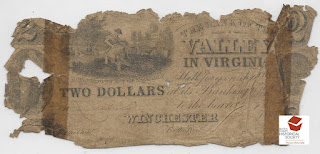These bank notes from the Benton County Historical Museum's
documents collection are worn and shabby, which is not too surprising as they
are over 150 years old! President
Andrew Jackson had vetoed renewal of the federal charter of the Second National
Bank which was set to expire in 1836. As a result, there were almost no checks
on the activities of state chartered banks and their numbers increased to 1562
by 1860. When one of these banks made a
loan, it gave the borrower a note on the bank.
Because anyone holding such a note could take it into the issuing bank
and receive official gold or silver coins, the notes were generally accepted in
payment for goods and services. Essentially, they were money.
 |
| 1855 Bank of the Valley $20 bank note |
 |
| $2 bank note from Bank of the Valley, Virginia |
The first bank note for $20 was issued in 1855 by the Bank
of the Valley. This bank was established
in 1818 in Winchester, Virginia and by the 1850s had branches in several other
towns in the Shenandoah Valley. The $2
bank note was issued sometime between 1830 and 1849 by the branch in Leesburg.
Bank of the Valley closed during the Civil War but reopened as the Shenandoah
National Bank in 1866.
 |
| 1857 $1 bank note from Savannah, Georgia |
The Merchants and Planters Bank of Savannah, Georgia issued
this $1 note in 1857, a year after it opened.
The bank failed in the 1860s.
This system created many problems. The difficulty of redeeming the notes of
banks in distant areas made them unacceptable to some businesses just as
out-of-state checks might be refused today. Also, people would not know if
distant banks were sound. Would they
have sufficient gold and silver to pay out on demand or had they printed so
many notes that their reserves were inadequate? Many notes traded at a discount so that a $1
note would only buy 90 cents worth of goods. Thick books were printed with the
discount rates to be applied to each of the approximately 300,000 notes in
circulation.
 |
| 1850 counterfeit bank note |
This 1850 note from the Hamilton Bank of Scituate, Rhode
Island represents an additional problem.
There was no such bank. There was
a Hamilton Bank in North Scituate which issued notes in 1849 with a different
set of officers listed. A group
purposely used a similar name and location in order to pass these notes off in
trade without ever planning on redeeming them! Anyone accepting one of these
notes suffered a loss.
Interestingly, most of the reverse sides of the notes were left blank.
By
Martha Fraundorf, Volunteer for Benton County Historical Society, Philomath,
Oregon










